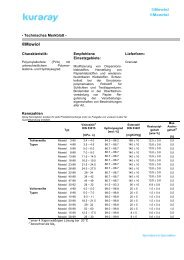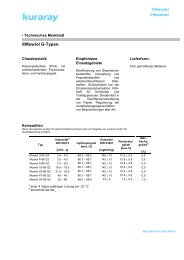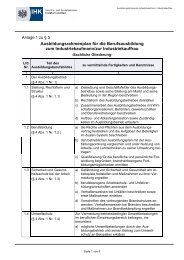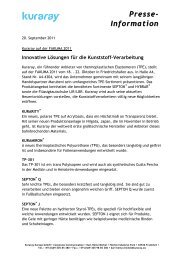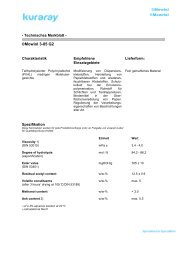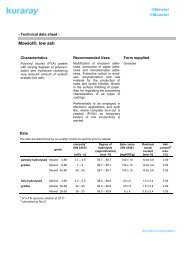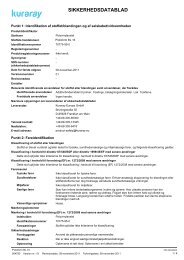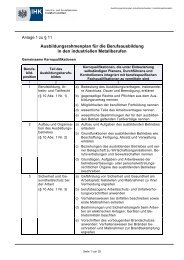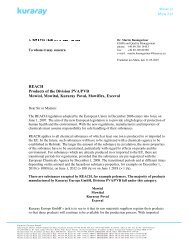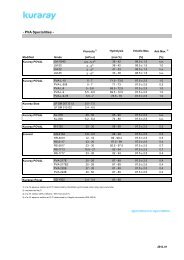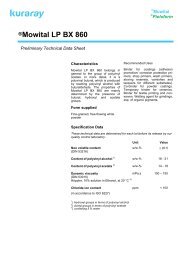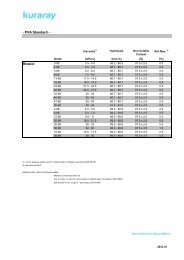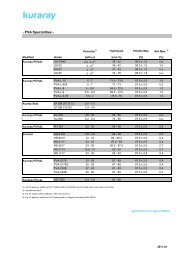SAFETY DATA SHEET - Kuraray Europe GmbH
SAFETY DATA SHEET - Kuraray Europe GmbH
SAFETY DATA SHEET - Kuraray Europe GmbH
You also want an ePaper? Increase the reach of your titles
YUMPU automatically turns print PDFs into web optimized ePapers that Google loves.
<strong>SAFETY</strong> <strong>DATA</strong> <strong>SHEET</strong><br />
Section 1: Identification of the substance/mixture and of the company/undertaking<br />
Product identifier<br />
Name of the substance<br />
Polyvinyl alcohol, partly saponified<br />
Trade name of the<br />
substance<br />
Mowiol, partly saponified<br />
Identification No. 25213-24-5<br />
Registration number<br />
-<br />
Synonyms 3-85, 4-88, 5-88, 8-88, 13-88, 18-88, 23-88, 26-88, 32-88, 40-88, 44-88, 47-88, 30-92, 4-88 LA,<br />
8-88 LA, 40-88 LA<br />
SDS number -<br />
Date of first issue 06-April-2011<br />
Version number 04<br />
Revision date<br />
20-September-2011<br />
Supersedes date<br />
23-August-2011<br />
Relevant identified uses of the substance or mixture and uses advised against<br />
Identified uses Additive. Adhesive. Auxiliary. Binder. Coatings. Protective colloid/dispersing agent. Raw material.<br />
Uses advised against None known.<br />
Details of the supplier of the safety data sheet<br />
Supplier:<br />
<strong>Kuraray</strong> <strong>Europe</strong> <strong>GmbH</strong><br />
Brüningstraße 50<br />
D-65926 Frankfurt am Main<br />
+49-69-305-85300<br />
Technical Contact:<br />
+49-69-305-6201<br />
Emergency telephone:<br />
+49-69-305-6418<br />
E-mail address:<br />
product-safety@kuraray.eu<br />
Section 2: Hazards identification<br />
Classification of the substance or mixture<br />
The substance has been assessed and/or tested for its physical, health and environmental hazards and the following<br />
classification applies.<br />
Classification according to Directive 67/548/EEC or 1999/45/EC as amended<br />
This substance does not meet the criteria for classification according to Directive 67/548/EEC as amended.<br />
Classification according to Regulation (EC) No 1272/2008 as amended<br />
This substance does not meet the criteria for classification according to Regulation (EC) 1272/2008 as amended.<br />
Hazard summary<br />
Physical hazards Not classified for physical hazards.<br />
Health hazards Not classified for health hazards. However, occupational exposure to the mixture or substance(s)<br />
may cause adverse health effects.<br />
Environmental hazards Not classified for hazards to the environment.<br />
Specific hazards Dusts may irritate the respiratory tract, skin and eyes. Exposed may experience eye tearing,<br />
redness, and discomfort. Liberated dust may irritate throat and respiratory system and cause<br />
coughing. Prolonged contact may cause dryness of the skin. Fine particles may form explosive<br />
mixtures with air.<br />
Main symptoms Coughing.<br />
Label elements<br />
Label according to Regulation (EC) No. 1272/2008 as amended<br />
Contains: Polyvinyl alcohol, partly saponified<br />
Identification No.<br />
25213-24-5<br />
Hazard statements The substance does not meet the criteria for classification.<br />
Precautionary statements<br />
Prevention Use personal protective equipment as required.<br />
Response No specific first aid measures noted.<br />
Mowiol, partly saponified<br />
901892 Version No.: 04 Revision date: 20-September-2011 Print date: 20-September-2011<br />
SDS IRELAND<br />
1 / 6
Storage Store in a dry place. Store in a closed container.<br />
Disposal Dispose of waste and residues in accordance with local authority requirements.<br />
Supplemental label information None.<br />
Other hazards Additional information is given in the Material Safety Data Sheet.<br />
Substance(s) formed under the<br />
conditions of use<br />
Not applicable.<br />
Section 3: Composition/information on ingredients<br />
Substance<br />
General information<br />
Chemical name<br />
Polyvinyl alcohol, partly saponified >93<br />
Classification: DSD: -<br />
CLP: -<br />
Methanol (Impurity)
For emergency responders Use personal protection recommended in Section 8 of the SDS.<br />
Environmental precautions Environmental manager must be informed of all major spillages.<br />
Methods and material for Avoid dust formation. Collect dust or particulates using a vacuum cleaner with a HEPA filter. Do<br />
containment and cleaning up not use compressed air when cleaning. For waste disposal, see section 13.<br />
Reference to other sections For personal protection, see section 8.<br />
For waste disposal, see section 13.<br />
Section 7: Handling and storage<br />
Precautions for safe handling Avoid inhalation of dust and contact with skin and eyes. Wear appropriate personal protective<br />
equipment. Wash hands after handling. Observe good industrial hygiene practices. Maintenance:<br />
Use work methods which minimise dust production. Use only in well-ventilated areas. Take<br />
precautionary measures against static discharges when there is a risk of dust explosion.<br />
Conditions for safe storage,<br />
including any incompatibilities<br />
Keep in original container. Store in a cool, dry, well-ventilated place. Store away from<br />
incompatible materials. Read and follow manufacturer's recommendations.<br />
Specific end use(s) Additive. Adhesive. Auxiliary. Binder. Coatings. Protective colloid/dispersing agent. Raw material.<br />
Section 8: Exposure controls/personal protection<br />
Control parameters<br />
Occupational exposure limits<br />
Ireland. Occupational Exposure Limits<br />
Components<br />
Type<br />
Value<br />
Form<br />
Dust (-) TWA 4 mg/m3 Respirable dust.<br />
10 mg/m3 Total inhalable dust.<br />
Methanol (Impurity)<br />
(67-56-1)<br />
STEL 310 mg/m3<br />
250 ppm<br />
TWA 260 mg/m3<br />
200 ppm<br />
EU. Indicative Exposure and Directives relating to the protection of risks related to work exposure to chemical, physical,<br />
and biological agents.<br />
Components<br />
Type<br />
Value<br />
Methanol (Impurity)<br />
(67-56-1)<br />
Recommended monitoring Not available.<br />
procedures<br />
DNEL Not available.<br />
PNEC Not available.<br />
Exposure controls<br />
Appropriate engineering<br />
controls<br />
TWA 260 mg/m3<br />
200 ppm<br />
Provide sufficient ventilation for operations causing dust formation. Follow above occupational<br />
exposure limit values for dusts. Ventilate as needed to control airborne dust. Use explosion-proof<br />
electrical equipment if airborne dust levels are high.<br />
Individual protection measures, such as personal protective equipment<br />
General information Personal protective equipment should be chosen according to the CEN standards and in<br />
discussion with the supplier of the personal protective equipment.<br />
Eye/face protection Risk of contact: Wear approved safety goggles.<br />
Skin protection<br />
- Hand protection It is a good industrial hygiene practice to minimise skin contact. For prolonged or repeated skin<br />
contact use suitable protective gloves.<br />
- Other Wear suitable protective clothing. It is a good industrial hygiene practice to minimise skin contact.<br />
Respiratory protection In case of inadequate ventilation or risk of inhalation of dust, use suitable respiratory equipment<br />
with particle filter (type P2).<br />
Thermal hazards Wear appropriate thermal protective clothing, when necessary.<br />
Hygiene measures Handle in accordance with good industrial hygiene and safety practices. Routinely wash work<br />
clothing and protective equipment to remove contaminants.<br />
Environmental exposure Contain spills and prevent releases and observe national regulations on emissions.<br />
controls<br />
Section 9: Physical and chemical properties<br />
Information on basic physical and chemical properties<br />
Appearance Powder or granules.<br />
Physical state Solid.<br />
Mowiol, partly saponified<br />
901892 Version No.: 04 Revision date: 20-September-2011 Print date: 20-September-2011<br />
SDS IRELAND<br />
3 / 6
Form Powder or granules.<br />
Colour White.<br />
Odour Odourless.<br />
Odour threshold Not available.<br />
pH 4.5 - 7<br />
Melting point/freezing<br />
point<br />
Not available.<br />
Boiling point, initial boiling<br />
point, and boiling range<br />
Not applicable<br />
Flash point > 93 °C (> 199.4 °F)<br />
Auto-ignition temperature Not applicable.<br />
Flammability (solid, gas) Not available.<br />
Flammability limit - lower<br />
(%)<br />
Not available.<br />
Flammability limit - upper<br />
(%)<br />
Not available.<br />
Oxidising properties Not applicable.<br />
Explosive properties Not applicable.<br />
Explosive limit Not applicable.<br />
Vapour pressure Not applicable.<br />
Vapour density Not applicable.<br />
Evaporation rate Not applicable.<br />
Relative density Not available.<br />
Solubility (water) Not available.<br />
Partition coefficient<br />
(n-octanol/water)<br />
No data available.<br />
Decomposition<br />
temperature<br />
Not available.<br />
Bulk density 400 - 600 kg/m3<br />
Viscosity Not available.<br />
Percent volatile < 5 % w/w<br />
Other information No relevant additional information available.<br />
Section 10: Stability and reactivity<br />
Reactivity Stable at normal conditions.<br />
Chemical stability Material is stable under normal conditions.<br />
Possibility of hazardous<br />
reactions<br />
Hazardous polymerisation does not occur.<br />
Conditions to avoid Contact with incompatible materials. Avoid dust close to ignition sources.<br />
Incompatible materials Strong oxidising agents. Strong acids.<br />
Hazardous decomposition<br />
products<br />
Carbon monoxide.<br />
Section 11: Toxicological information<br />
General information Dusts or powder may irritate the respiratory tract, skin and eyes.<br />
Information on likely routes of exposure<br />
Ingestion May cause discomfort if swallowed.<br />
Inhalation Dust irritates the respiratory system, and may cause coughing and difficulties in breathing.<br />
Skin contact Dust may irritate skin.<br />
Eye contact Dust may irritate the eyes.<br />
Symptoms Dust may irritate throat and respiratory system and cause coughing. Direct contact with eyes may<br />
cause temporary irritation.<br />
Information on toxicological effects<br />
Acute toxicity Dust may irritate the respiratory tract, skin and eyes. Harmful if inhaled or swallowed.<br />
Components Test results<br />
Methanol (Impurity) (67-56-1) Acute Dermal LD50 Rabbit: 17100 mg/kg<br />
Acute Inhalation LC50 Rat: 128200 mg/m³ 4 Hours<br />
Mowiol, partly saponified<br />
901892 Version No.: 04 Revision date: 20-September-2011 Print date: 20-September-2011<br />
SDS IRELAND<br />
4 / 6
Components Test results<br />
Acute Oral LD50 Rat: 1187 - 2769 mg/kg<br />
Skin corrosion/irritation Dust may irritate skin.<br />
Serious eye damage/eye<br />
irritation<br />
Dust may irritate the eyes. Exposed may experience eye tearing, redness, and discomfort.<br />
Respiratory sensitisation Not classified.<br />
Skin sensitisation Not a skin sensitiser.<br />
Germ cell mutagenicity Not expected to be mutagenic.<br />
Carcinogenicity Not classified.<br />
Reproductive toxicity Not classified.<br />
Specific target organ<br />
toxicity - single exposure<br />
No data available.<br />
Specific target organ<br />
toxicity - repeated<br />
exposure<br />
No data available.<br />
Aspiration hazard Due to the physical form of the product it is not an aspiration hazard.<br />
Mixture versus substance Not applicable.<br />
information<br />
Other information Pre-existing skin and respiratory conditions including dermatitis, asthma and chronic lung disease<br />
might be aggravated by exposure.<br />
Section 12: Ecological information<br />
Toxicity<br />
Components Test results<br />
Methanol (Impurity) (67-56-1)<br />
EC50 Algae: 22000 mg/l 96 hours<br />
EC50 Daphnia magna: > 10000 mg/l 48 hours<br />
LC50 Fish: 15400 mg/l 96 hours<br />
Persistence and<br />
degradability<br />
No data available.<br />
Bioaccumulative potential No data available.<br />
Mobility Not available.<br />
Environmental fate -<br />
Partition coefficient<br />
No data available.<br />
Mobility in soil Not available.<br />
Results of PBT and<br />
vPvB assessment<br />
Not available.<br />
Other adverse effects The product is not classified as environmentally hazardous. However, this does not exclude the<br />
possibility that large or frequent spills can have a harmful or damaging effect on the environment.<br />
Section 13: Disposal considerations<br />
Waste treatment methods<br />
Residual waste Dispose of in accordance with local regulations.<br />
Contaminated packaging Dispose of in accordance with local regulations.<br />
EU waste code 08 02 01<br />
Disposal methods/information Dispose of in accordance with local regulations.<br />
Section 14: Transport information<br />
ADR<br />
The product is not covered by international regulation on the transport of dangerous goods.<br />
RID<br />
The product is not covered by international regulation on the transport of dangerous goods.<br />
ADN<br />
The product is not covered by international regulation on the transport of dangerous goods.<br />
IATA<br />
The product is not covered by international regulation on the transport of dangerous goods.<br />
IMDG<br />
The product is not covered by international regulation on the transport of dangerous goods.<br />
Mowiol, partly saponified<br />
901892 Version No.: 04 Revision date: 20-September-2011 Print date: 20-September-2011<br />
SDS IRELAND<br />
5 / 6
Transport in bulk according to<br />
Annex II of MARPOL73/78 and<br />
the IBC Code<br />
Section 15: Regulatory information<br />
No information available.<br />
Safety, health and environmental regulations/legislation specific for the substance or mixture<br />
EU Regulations<br />
Regulation (EC) No. 2037/2000 on substances that deplete the ozone layer, Annex I<br />
Not listed.<br />
Regulation (EC) No. 2037/2000 on substances that deplete the ozone layer, Annex II<br />
Not listed.<br />
Regulation (EC) No. 850/2004 on persistent organic pollutants, Annex I<br />
Not listed.<br />
Regulation (EC) No. 689/2008 concerning the export and import of dangerous chemicals, Annex I, part 1<br />
Not listed.<br />
Regulation (EC) No. 689/2008 concerning the export and import of dangerous chemicals, Annex I, part 2<br />
Not listed.<br />
Regulation (EC) No. 689/2008 concerning the export and import of dangerous chemicals, Annex I, part 3<br />
Not listed.<br />
Regulation (EC) No. 689/2008 concerning the export and import of dangerous chemicals, Annex V<br />
Not listed.<br />
Directive 96/61/EC concerning integrated pollution prevention and control (IPPC): Article 15, <strong>Europe</strong>an Pollution<br />
Emission Registery (EPER)<br />
Not listed.<br />
Regulation (EC) No. 1907/2006, REACH Article 59(1). Candidate List<br />
Not listed.<br />
Other regulations This Safety Data Sheet complies with the requirements of Regulation (EC) No 1907/2006.<br />
National regulations Not available.<br />
Chemical safety assessment No Chemical Safety Assessment has been carried out.<br />
Section 16: Other information<br />
List of abbreviations DNEL: Derived No-Effect Level.<br />
PNEC: Predicted No-Effect Concentration.<br />
CLP: Regulation No. 1272/2008.<br />
DSD: Directive 67/548/EEC.<br />
References Not available.<br />
Information on evaluation Not available.<br />
method leading to the<br />
classification of mixture<br />
Full text of any statements or<br />
R-phrases and H-phrases<br />
under Sections 2 to 15<br />
R11 Highly flammable.<br />
R23/24/25 Toxic by inhalation, in contact with skin and if swallowed.<br />
R39/23/24/25 Toxic: danger of very serious irreversible effects through inhalation, in contact with<br />
skin and if swallowed.<br />
H225 - Highly flammable liquid and vapour.<br />
H301 - Toxic if swallowed.<br />
H311 - Toxic in contact with skin.<br />
H331 - Toxic if inhaled.<br />
H370 - Causes damage to organs.<br />
Training information Follow training instructions when handling this material.<br />
Further information The substance is classified based on test data for physical hazards. The classification for health<br />
and environmental hazards is derived by a combination of calculation methods and test data, if<br />
available. For details, refer to Sections 9, 11 and 12.<br />
THIS <strong>SAFETY</strong> <strong>DATA</strong> <strong>SHEET</strong> CONTAINS REVISIONS IN SECTIONS: 1, 8, 9, 13, 16.<br />
Disclaimer This information is provided without warranty. The information is believed to be correct. This<br />
information should be used to make an independent determination of the methods to safeguard<br />
workers and the environment.<br />
Issue date 20-September-2011<br />
Revision date 20-September-2011<br />
Print date 20-September-2011<br />
Mowiol, partly saponified<br />
901892 Version No.: 04 Revision date: 20-September-2011 Print date: 20-September-2011<br />
SDS IRELAND<br />
6 / 6



